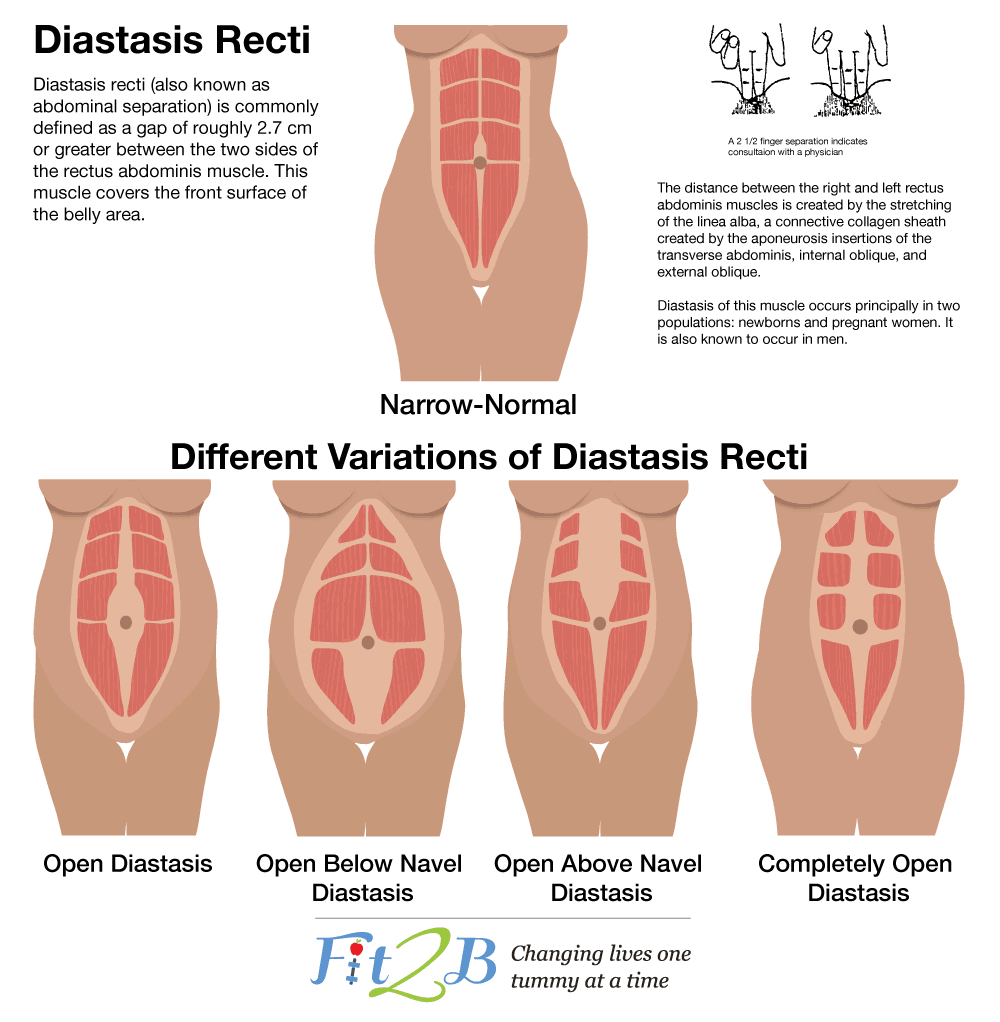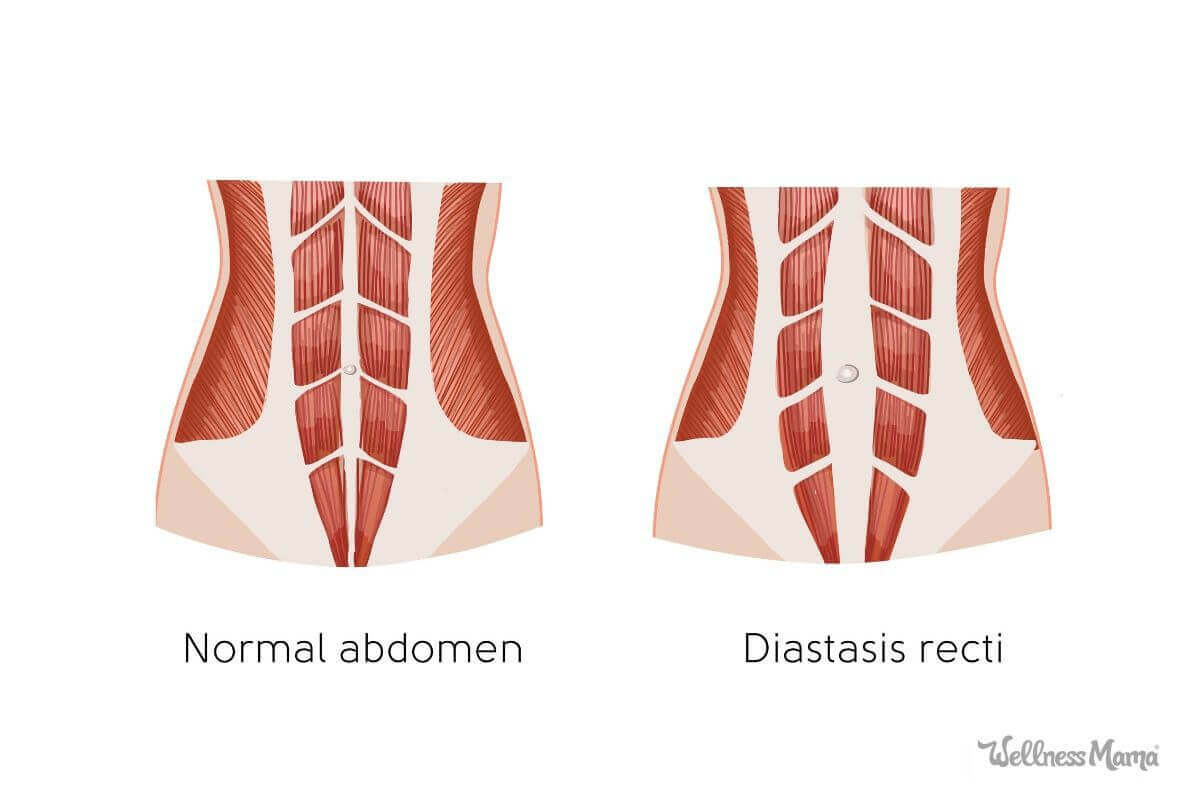Oh motherhood! When we enter the amazing journey of carrying, birthing and raising a child, we learn many terms that previously we’d be unable to define… like perineal tear, sitz bath, and for many of us, unfortunately, also diastasis recti.
Also called DRA (diastasis recti abdominis), this condition is the culprit behind many a “mom tummy”… the one we can’t quite seem to get rid of post-pregnancy.
What the Heck Is Diastasis Recti?
In medical terms, according to the Mayo Clinic, diastasis recti occurs when:
During pregnancy, the growing uterus stretches the muscles in the abdomen. This can cause the two large parallel bands of muscles that meet in the middle of the abdomen to separate — a condition called diastasis recti or diastasis rectiabdominis. Diastasis recti might cause a bulge in the middle of the abdomen where the two muscles separate.
In mom terms, it is that frustrating post-baby pooch that doesn’t go away when the baby weight does and often leads to the “when are you due” question while you are holding your two year old. (Not speaking from experience or anything! *ahem*)
It is also the thing that can keep jeans fitting incorrectly even when you are the same size/weight as pre-pregnancy, and at the extreme, diastasis can be connected to lower back pain, abdominal pain, and even pelvic problems.
Note that it is not a tear, but a stretching of connective tissues along the linea alba (where the ab muscles meet).
Why does this happen? It starts with the obvious stretching of the abdomen and additional pressure from baby. Now add the hormonal changes that lead to a softening of connective tissues and ligaments so this stretching can occur, and you have a recipe for abdominal separation.
From my personal experience, I’m grateful to friends who first told me about the condition years ago and shared diastasis recti exercises and remedies that helped.
Risk Factors for Diastasis
As moms, we share advice and air our woes on everything from breastfeeding to potty training, but we are more hesitant to open up about the abdominal, urinary, and pelvic problems that can come postpartum for many of us. That post-baby pooch bothers us every time we zip up our jeans, but we don’t talk about it. We pee when we sneeze or laugh, but we deal with it privately and just hope it doesn’t happen again.
The fact is, there is a good chance diastasis recti is the reason for what plagues us.
Statistically, 98+% of women have a diastasis after delivery. It is more likely to happen when:
- the more pregnancies a woman has (I can attest to this)
- a mom has multiples
- or an underlying abdominal problem (like weak core muscles) already exists.
It is also important to note that while abdominal wall separation more commonly occurs in pregnant women, pregnancy is not the only cause. Men and children can suffer from a separation as well due to unusual internal abdominal pressure, such as after a surgery or injury. (This video explains more.)
Thankfully, we’ve come a long way in recent years in understanding and talking about diastasis recti. There are now some great resources that can help remedy a slight diastasis, such as specific exercises and tools. (More on that below.)
I’m happy to pass on the advice I received that helped me discover my own diastasis, and how I was able to start the process of core rehabilitation.
How I Discovered My Diastasis…
During my pregnancy with my first child, I continued doing abdominal specific exercises like crunches because I thought it would actually help my body stay fit and recover more quickly after pregnancy.
Turns out, it did the opposite. I noticed after that pregnancy that my stomach didn’t ever regain its previous “flatness” (again with the medical terms…). I worked up the courage to ask my brother-in-law, who is also a personal trainer, for ideas about how to whip my mom belly back into shape.
Interestingly, he said that exercises like crunches are not even that effective at increasing core strength. Instead, he recommended bodyweight exercises, kettlebells, and pull-ups.
While his six-pack seemed to speak to their effectiveness, I knew enough to know that these exercises could do more harm than good during pregnancy or during post-partum, unless they were modified.
Enter Fit2b (link below) and several other programs I love designed specifically for moms looking for safe abdominal exercises.
How to Self-Check for Diastasis
After I learned what diastasis was, I completed a self-check to see if I had it.
According to Fit2b, the program I followed for my self-check:
- Diastasis is a gap of more than 2.7 centimeters between the ab muscles
- A finger width gap check at home can tell you whether or not you have a separation. As any pregnant woman who has been checked in labor can attest, “centimeter” measurements can vary greatly by finger size of the person checking, so this isn’t an exact science but a rough way to gauge a potential problem.
- Generally you are looking for a gap of more than 2-3 fingers.
How to do it:
Emily of Holistic Squid explains the basic steps of checking for a diastasis:
- Get in a comfortable starting position. Lie on your back with your knees bent, feet flat on the floor.
- Place your fingers on either side of your belly button, palms facing down.
- Lift your head and neck just slightly off the floor while you press down with your fingers. If there is a gap, that is the diastasis.
- Conduct the same test just above your belly button and just below the belly button (as the gap can measure differently in these places).
Don’t worry, this article has excellent instructions and a video that explains how to self-check for a diastasis, and their graphic shows the potential types of abdominal separation that can occur:

This video also gives a visual demonstration of the process:
What to Do If You Have Diastasis: Exercises, Splints & More
Unfortunately, dealing with diastasis recti isn’t as simple and straightforward as many natural remedies are.
From what I’ve read and the programs I’ve used, many smaller separations can be helped at home with specialized exercises (these are what helped me) but severe cases can sometimes need a physical therapist or even surgery.
For me, exercises were enough in past pregnancies, though I had to rely on YouTube videos and exercises that friends had shared. Now, there are several specific programs created by DRA experts, and I’ll be using these after this little one arrives. In fact, many of you have recommended these programs in comments and in social media (if you’ve used either one, please let me know in the comments and share your experience!)
- Fit2b: A family-friendly workout membership that has specific videos for diastasis. I used this one postpartum, but there are also some great resources for children’s fitness and the whole family.
- MuTu: A 12- week focused program that addresses diastasis as well as other pelvic health issues. Some of our Wellness Mama team have used it with great success.
- Pregnancy Exercise.co.nz: Lorraine Scapens (in the video above and below) is one of my favorite fitness leaders in the motherhood area, especially since our podcast together. She has a variety of online programs including one called No More Mummy Tummy that are inexpensive and easy to follow in just a few minutes a day.
Here Lorraine shows breathing exercises that isolate the transverse abdominal muscles as a first step in resolving the issue:
Diastasis: Exercises to Avoid
As with many aspects of nutrition, sometimes what you avoid can be just as important as what you do…
Sources agree that many exercises specifically targeted at core strength should actually be avoided if a person has an abdominal separation. Movements like crunches, sit-ups, and planks can actually make things worse instead of better. To quote this article from MutuSystem.com:
Doing a standard crunch or sit-up is generally not recommended for postpartum women, especially when we know a diastasis recti or DRA is present. This is because the way a crunch is generally performed has the effect of severely increasing intra abdominal pressure, pushing your organs outwards against or through the gap, and downwards onto the pelvic floor – directions you really don’t want your organs forcefully heading.
In fact, even if you don’t have diastasis recti, recent research suggests that isolation exercises like sit-ups and crunches are hard on the back and not effective anyway (Harvard Health agrees).
How Reduce Diastasis Risk During Pregnancy
This is the question I’ve always had…
Since the large majority of women have a DRA after delivering a baby, and since pregnancy and pushing make the problem worse, is there anything that can be done to help stop the problem to begin with or avoid it during pregnancy?
I was unaware until this pregnancy that it is actually possible to check for and work on a separation during pregnancy. and it may even be easier to detect at this time.
I found this Q&A about diastasis in pregnancy very helpful. In short, pregnancy doesn’t actually cause the separation, abdominal pressure does, but pregnancy of course often contributes to this pressure.
There have been cases of women who were able to reverse a separation during pregnancy, and there are steps that can help during pregnancy, including:
- Avoiding any movement like a crunch or situp that isolates the abdominal muscles
- Avoiding “rib thrusting” (here’s what it is and how to avoid it)
- Getting up with correct posture to avoid strain on the core (bend your knees and support yourself with your arms)
- Focusing on comprehensive movements like squats (with proper form!) to help strengthen the body correctly (this tutorial was very helpful to me)
Does a Splint or Binder Help?
Sources seem to be divided on this subject. From my personal experience, a splint helped a lot immediately post-delivery and for a few weeks in conjunction with approved exercises (once I was allowed to do them).
My midwife in past pregnancies and the Fit2b program recommend tummy splinting, especially in the short time after delivery. The Tummy Team website has some great articles and resources that address the potential benefits of splinting.
The MuTu system offers a different perspective, suggesting that splinting does not actually help the abdominal muscles reattach and that it may impede the body’s ability to resolve the issue correctly.
With research and sources divided, this is an issue that I personally spoke to my own midwife about before making a decision. Like I said, in the past, a splint greatly helped my postpartum pain and healing, but I used it in conjunction with exercises and had good results.
When to Seek Professional Help?
I have several friends who benefitted from seeing a physical therapist for a short time to address their specific diastasis recti problems. I haven’t done this personally, but absolutely would if I had a severe separation. To find a therapist who specializes in DRA problems, go to The American Physical Therapy Association’s website and choose “women’s health.”
Other Diastasis Resources
- Diastasis Printables
- Good review of the Tupler Technique– another possible solution
- Under Pressure from Katy Says
- The programs mentioned above
Do you have diastasis? What helped you? Please share your experience in the comments as this issue seems to affect many of us!

This article was medically reviewed by Dr. Scott Soerries, MD, Family Physician and Medical Director of SteadyMD. As always, this is not personal medical advice and we recommend that you talk with your doctor.


Leave a Reply